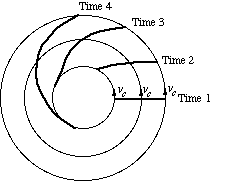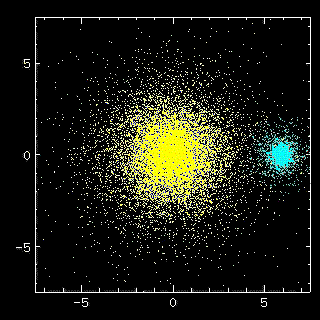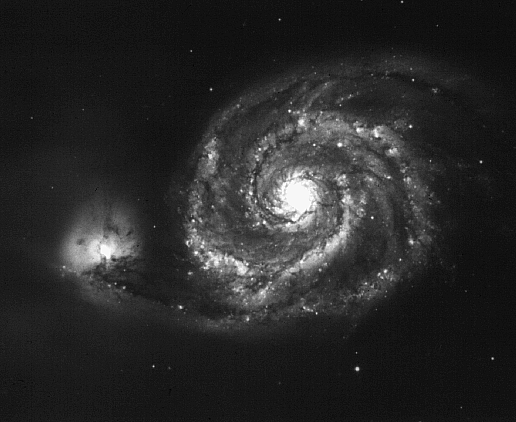 |
NO, if this were the case, the arms would become more tightly wound with time. Since it takes the Sun only about 200 million years to orbit the Galactic Center, the spiral pattern would have wound up tight and disappeared long ago. |
Key points: What creates spiral arms; nature of density waves
Are the spiral arms in galaxies just the result of stars closer to the center orbiting faster than those further out?
 |
NO, if this were the case, the arms would become more tightly wound with time. Since it takes the Sun only about 200 million years to orbit the Galactic Center, the spiral pattern would have wound up tight and disappeared long ago. |
In fact, we have trouble accounting for prominent spiral arms for any galaxy that is not given some kind of "kick."
| As an illustration, here is a calculation of the behavior of an
isolated galaxy (from
F. Bournaud and F. Combes, http://www.obspm.fr/actual/nouvelle/aug02/accretion.en.shtml).
The old stars are in red, the young stars in blue, the gas is in yellow. After the
development of a spiral, a bar is formed by disk instability in the first 500 million
years. This bar soon will weaken, then disappear, but other bars will replace it, for
example the second strong bar at about 7 billion years, at the end of the animation.
Although galaxies look solid and substantial,
in fact they are more like the jellyfish of outer space and adjust their
form continuously!
|
 |
Two processes together appear to account for prominent spiral arms:
1) First, the galaxy disk needs to be disturbed
a.) star formation is triggered by a nearby supernova explosion, passing galaxy, or something else the imposes an expanding shock that moves through the galaxy
b.) galaxy disks are not very stable, so this shock can trigger larger scale instabilities
2) Density Waves
Once the disk of the galaxy has been perturbed, it tends to form large-scale arm-like density enhancements that the stars and gas move through. We all have experienced density waves -- density waves of cars are what cause traffic jams! (from William Beaty, http://amasci.com/amateur/traffic/trafexp.html, smashup added by G. Rieke)
|
 |
||||||
Gas clouds move into these density enhancements, they are slowed by the local gravitational field, and as a result they are compressed to trigger the formation of new stars which in turn can light up the HII regions. Another possibility is that the clouds are more likely to collide in the density wave, just like there are more accidents among cars caught in a traffic slow-down; the collisions can help compress the clouds.
Young, bright stars show where the density wave just passed
 |
We show the idea schematically as a green molecular cloud passes through a red spiral arm. The cloud is compressed and starts to form massive blue stars, which quickly evolve into supernova explosions (yellow). (animation by G. Rieke) |
The effects are enhanced substantially if the disk is disturbed from outside, for example by collision with a smaller galaxy (collisions with large galaxies are usually too disruptive for the disk to survive). For example, a collision of a large galaxy with a disk with a small galaxy is simulated to the left. Compare it with M51 to the right. (simulation from Chris Mihos, http://burro.astr.cwru.edu/Academics/Astr222/Galaxies/Spiral/spiral.html)
 |
 |
|
In the 18th Century, Thomas Wright proposed that theUniverse was filled with groupings of stars like the Milky Way, fromhttp://homepage.mac/com/kvmagruder/bcp/milky/shape.htm
|

Starburst candy |
|
Click to return to syllabus |
||
| Click to return to Distribution of Galaxies in Space | hypertext |
Click to go to Growing Galaxies |